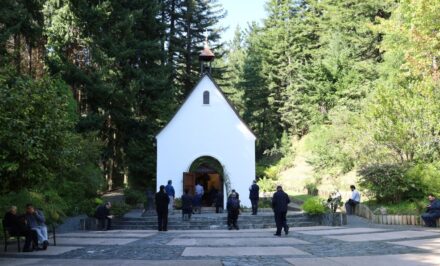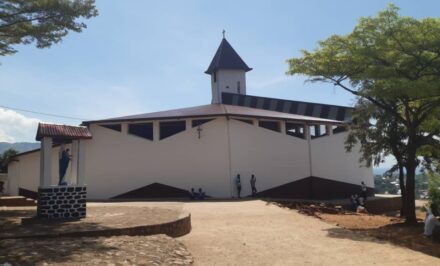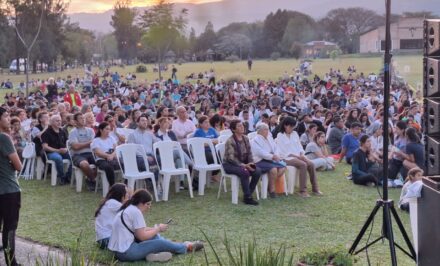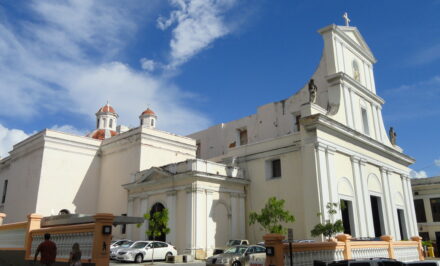GERMANY, Press Office Fulda Diocese, Maria Fischer •
A great celebration for the whole of the diocese of Fulda is approaching: On Sunday, 31 March, the new Bishop of Fulda, Dr Michael Gerber (49) will be solemnly installed as Bishop in Fulda Cathedral. The installation takes place at 3 p.m. by the competent Metropolitan, Archbishop Hans-Josef Becker (Paderborn), in the framework of solemn High Mass. HR-TV will broadcast the service live from Fulda Cathedral. More than a thousand guests are expected to attend. –
The Apostolic Nuncio to Germany, Archbishop Dr Nikola Eterović (Berlin), and many bishops and auxiliary bishops, as well as ecumenical representatives and guests from the social and political fields are expected to attend. Among them will be the Chairman of the German Bishops’ Conference, Reinhard Cardinal Marx (Munich), the Prime Minister of Hessen, Volker Bouffier (CDU), and Professor Martin Hain, Bishop of the Evangelical Church of Kurhessen-Waldeck. The celebration will be introduced from 2.30 p.m. in the Cathedral with prayer and music. The inauguration will be broadcast to screens in the Cathedral square and the city parish church.
In the tradition of St Boniface
The inaugural ceremonies have consciously been contextualised in the 1275-year-old tradition of the Imperial Abbey of Fulda that goes back to St Boniface, the Apostle to the Germans and Patron of the diocese. During the liturgy the ancient 12th century crosier of the Fulda Abbots and Bishops, known as the “Boniface Staff”, will be used. In addition one of the three extant Boniface manuscripts, the so-called Radyndrudis Codex from the 8th century, will be on display. According to tradition. St Boniface held this book protectively as he was martyred.
The new bishop will walk in procession from the Theological Faculty to the open door of Fulda Cathedral, where he will be met by the Cathedral Chapter. After the procession has arrived, Archbishop Becker will open the Mass. The Papal Nuncio will hand over the papal letter of appointment to the new bishop, who will pass it on to the Dean, Prof. Dr Werner Kathrein. He will then show it to the members of the Cathedral Chapter. The Cathedral chaplain, Fr Thomas Renze, will then read a German translation of the Latin document from the ambo. After this the Archbishop of Paderborn will present the “Boniface Staff” to Bishop Gerber and accompany him to the Cathedra where the Bishop will take his seat. His new coat of arms has already been put up above the bishop’s throne. As a sign of their communion the representatives of the clergy and People of God shake the bishop’s hand.
First sermon of the new Bishop of Fulda
Bishop Gerber will concelebrate Holy Mass with Archbishop Becker, the Papal Nuncio, Archbishop Eterović, Cathedral administrator, Auxiliary Bishop Karheinz Diez, Emeritus Bishop Heinz Josef Algermissen, Archbishop Stephan Burger and Emeritus Archbishop Robert Zollitsch (both of Freiburg), Dr. Christian Löhr, Superior General of the Institute of Schoenstatt Diocesan Priests of which Bishop Gerber is a member, Fr Lukas Wehrle (Oberkirch), Bishop Gerber’s home parish priest, and Fr Sebastian Blümel (Marberg), spokesperson from the former priests’ council. The deacon who will assist at Holy Mass will be Michael Huf, advisor to the permanent deacons in Fulda diocese. In the framework of the celebration of Holy Mass Bishop Gerber will also give his first sermon as diocesan bishop. The Cathedral Choir under the direction of Franz-Peter Huber will sing parts of the “Mass of L. de Saint-Martin” during the Mass. Besides this, the “Entrata festiva” of F. Peeters, “Deo dicamus gratias” of G.A. Homilius, the “Cantique de Jean Racine” by G. Fauré, the “Ubi caritas” of O. Gjeilo, as well as other choral settings will be sung in turn with the congregation. During Holy Mass a wind ensemble will make a contribution; the Cathedral Organist, Prof. Hans-Jürgen Kaiser, will play the cathedral organ, and Andreas Schneidewind will play the choir organ.
At the end of Holy Mass Cardinal Marx, President of the German Bishop’s Conference, will address the assembly, followed by Prime Minister Bouffier and Evangelical Bishop Dr Hein. After this Bishop Gerber will appoint his Vicar General as his first official act, as well as the officials and the diocesan vicars, or confirm them in office, and finally give his blessing with the “Boniface Staff”.
Following the Solemn High Mass, all the faithful are invited to meet Bishop Gerber in the Diocesan Seminary.
On 13 December last year Pope Francis appointed Auxiliary Bishop Gerber of Freiburg as the spiritual leader of the Fulda Diocese and the youngest German Bishop until now. He is thus the successor of Bishop Algermissen, who retired on 5 June 2018. When Bishop Gerber assumes office, the office of diocesan administrator exercised since June by Auxiliary Bishop Diez, will come to an end. After being vacant for less than ten months the dioceses of St Boniface will again have a resident bishop.
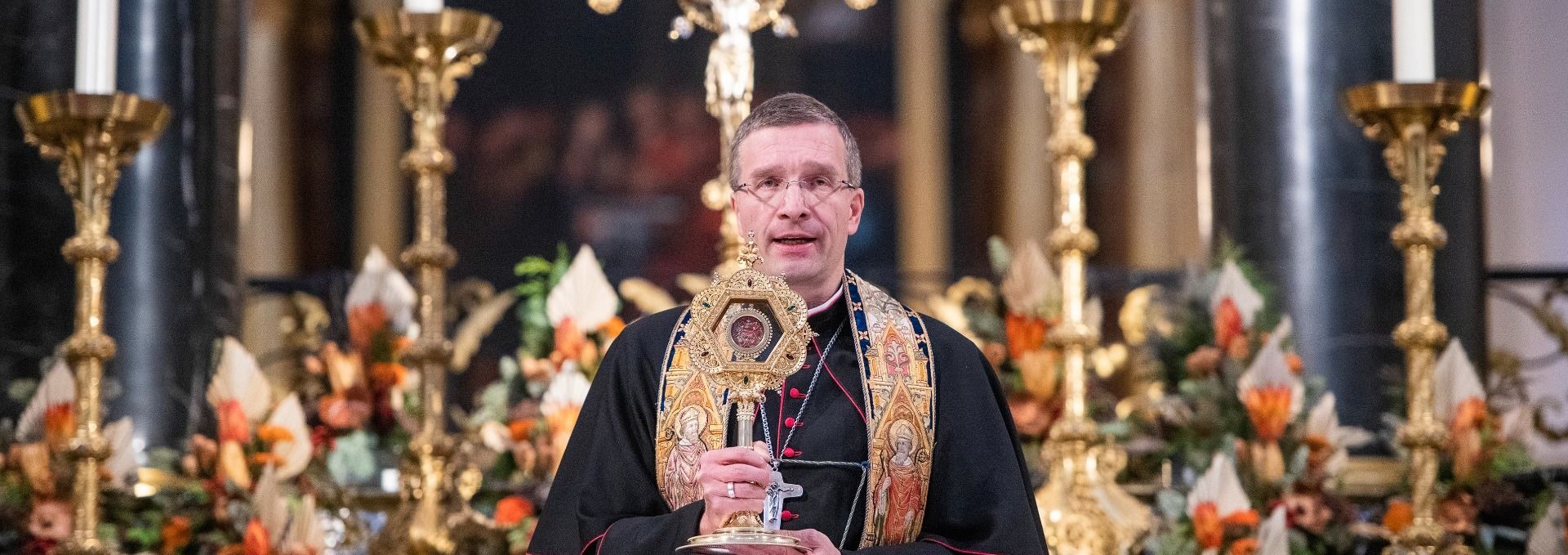
Bishop Gerber’s vision of a Church as Movement
In a talk he gave to the German Family Federation Bishop Michael Gerber described what “Movement” and “Church as Movement” mean. A vision and challenge.
“It has been the experience of our Schoenstatt Movement that we have been given the model of a Movement. What incentives can this give us for our image of the Church in the world of today? If we look at it more closely, we will find the image of a Movement in the social structure of Jesus’ disciples just as the Gospels describe it:
There are those who tried to stake everything on the one card – “Jesus”. They wanted to imitate Jesus. They wanted to understand their lives and all that they did entirely in relation to Jesus. The “Twelve” naturally belonged to this group, as well as other men and women who followed Jesus.
In addition, there were those – to use our modern terminology – who got involved with Jesus as a “project”.
For example Mary and Martha of Bethany. In other words they said to Jesus: “We want to follow you, but we won’t invest all our time and strength in your mission, but when you come to us, you and your disciples will be given what we have to offer, that is, accommodation and a good meal.”
Finally, there are those who came into contact with Jesus from time to time. Many people in salvation history fit in here. They had a unique encounter with Jesus. The bridal couple at Cana is one of them. We have often meditated on this passage of Scripture. Who actually asked their names? We don’t find this in St John’s Gospel. We know Simon of Cyrene’s name and that he was the father of Rufus and Alexander, which indicates that at the time when the first Gospel was written down Simon, or at least his sons, were in vital contact with the first group of Christians. The bridal couple at Cana weren’t. The place was known, and there was a Christian community in Galilee. Did the couple die rather early? Or did they have no contact with the Christian community later?
The Gospels do not pass judgement. They don’t say that the one is better than the others. What is interesting is that just the disciples, that is, those who staked everything on following Jesus, are always described as the ones who understood nothing. The bridal couple at Cana, who appear nowhere else, remain a constant message with their experience until today. That can be an initial incentive for us. What is our attitude to those who only get involved with Church life through projects, or from time to time? We may admit that it hurts us that the families of First Communicants disappears after the First Communion of their children. But – let me repeat – what is our perspective when we look at these people? Is our main thought: Actually they should …? These people will notice it and it won’t motivate them to look for closer contact with Church life. Or, do we look at these people from a Biblical perspective: “What could they be saying to us?”
We are very familiar with the jar that connects us to the Gospel of the marriage at Cana. We don’t know the names of the couple. They probably didn’t have much to do with the first Christian community. Yet, with their experience the couple has a message for us. So in future, when we meet such a person or family who “only” come to Church from time to time, and then disappear, we can think of the jar and its history – and: place it into the jar.
The Church as Movement
It seems to me that when the early Church described the social structure of Jesus’ disciples, it showed the dynamics between the Church and the individual parts of the Church. The Church as a whole, and the individual parts of the Church, as well as the parishes, need a “glowing core”. This is provided by people who have undertaken a conscious decision to follow Jesus. These are people who are conscious of their limitations and weaknesses, but still say that “together with you in the covenant” our lives will succeed and we will live our mission for Christ, for the Church, and for the people of our times. If this “glowing core” is missing, the Church will mutate into a sort of non-regenerating organisation that follows up interesting projects, but has lost its heart and centre.
If, as the Family Federation, you live the spirit of the Evangelical Counsels, you really want to live the reality of this “glowing core”. Just as with Jesus’ disciples, this core has to be experienced as the togetherness of different charisms. Among the circle of disciples there were the Apostles who had received a special commission. However, there were also many men and women who lived a similarly radical discipleship.
Our concern today has to be to care for the “glowing core”. We can feel that by looking at the social structure of Jesus’ disciples the question can change. We are not concerned in the first place with asking “are there still enough celibate men as priests, and women as Sisters, who secure the life of our Church?” The question is: “Are there people who decide in their chosen way of life to follow Jesus and want to live as part of this ‘glowing core’”? That is the question behind the question. As Rector I have often experience that someone has set off along the path to the priesthood for various motives, and then has to clarify whether he understands it as his very personal way of living his discipleship, or simply as an interesting office. In its very different substructures of a dioceses and parishes, our Church needs a critical mass that is ready to live as followers of Jesus in the sense of a “glowing core”.
Original: German. Translation: Mary Cole, Manchester, United Kingdom




